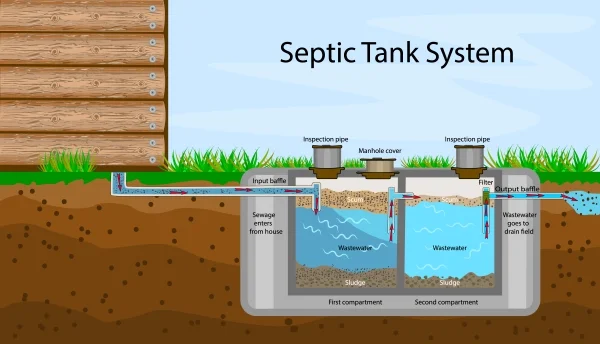
Septic tanks are common, especially for homes in rural areas. Rather than household plumbing waste flowing to municipal treatment plants, it’s sent into a septic tank installed near the home. A septic tank treats plumbing waste via the process of biologically decomposing solids and filtering liquids through the surrounding soil. There are a few things to keep in mind to keep a septic tank in good condition. Remember that your local Mr. Rooter® Plumbing can help with any of your septic needs.
How Does a Septic Tank Work?
Septic systems use a simple design to treat household waste. Here’s how a septic tank works:
- Plumbing waste leaves the home through waste pipes and empties into the tank, which is usually made of concrete, fiberglass, or plastic.
- In the septic tank, solids sink to the bottom where they’ll break down over time via bacterial decomposition. The balance of bacteria in a septic system is vital to keep it working well, which is why pouring harsh chemicals down your drains is a bad idea if you’re on a septic system. Chemicals like bleach can harm the bacteria that keep the system working.
- As solids sink to the bottom, liquids slowly flow through a pipe on the other end of the septic tank that leads to a leach field (also called a drain field). A leach field is an array of perforated pipes.
- In the drain field, the water slowly drips out of the pipes and into the surrounding soil, which naturally filters and cleans the liquid before it returns to the water table.
After some time, the septic tank ends up full of solid waste, oils, and sludge. To keep the system in working order, this needs to be pumped out by a professional. In general, a septic system needs to be pumped out every three years or so. The ideal pumping frequency for your septic tank depends primarily on how much stress the system is under and your household size.
Related Topic: How to Find Your Septic Tank Lid
Can a Septic Tank Be Above Ground?
While most septic tanks are installed below ground, sometimes conditions on a site don’t allow for underground septic tanks. If the soil is mostly bedrock and can’t be easily dug to install an underground tank, or if the native soil doesn’t drain well, conditions might not be right for a traditional underground system and an above-ground tank is the best option.
These above-ground septic tanks are usually composed of plastic and hold between 1,300 and to 4,500 litres of waste. They’re installed with a mound of gravel, sand, and soil nearby. Solid wastes are deposited into the first chamber of the tank, and liquids go into a second chamber before being pumped out into the gravel mound to be filtered and dispersed. Above-ground septic tanks must be pumped out more frequently than traditional buried systems.
Proper Tank Maintenance
Your septic tank system is something you rely on every day. Making sure it is operating properly is essential to ensuring a healthy household. To keep a septic tank and system in good working order, it needs to be pumped, maintained, and occasionally repaired. A well-maintained system can keep working well for decades. If you have any questions, or concerns, or need help with your septic tank system, contact your local Mr. Rooter. We can perform and complete and thorough inspection of your system, perform any necessary maintenance and set you with a plan to ensure it continues to run smoothly all year long. To learn more, or get started give us a call or request a estimate online.